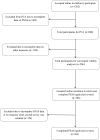The Postpartum Specific Anxiety Scale: development and preliminary validation
- PMID: 27571782
- PMCID: PMC5102940
- DOI: 10.1007/s00737-016-0658-9
The Postpartum Specific Anxiety Scale: development and preliminary validation
Abstract
Perinatal symptoms of anxiety are increasingly recognised due to their high prevalence and impact. Studies using pregnancy-specific anxiety measures have found that they may predict perinatal outcomes more effectively than general measures. However, no such measure exists to assess anxieties specific to the postpartum. This study aimed to develop and validate a measure (Postpartum Specific Anxiety Scale; PSAS) that accurately represents the specific anxieties faced by postpartum women, using a four-stage methodology: (1) 51 items were generated from interviews conducted with a group of 19 postpartum women at two time points, (2) the scale was reviewed and refined by a diverse expert panel, (3) an online pilot study (n = 146) was conducted to assess comprehensibility and acceptability and (4) an online sample of 1282 mothers of infants up to 6 months old completed the PSAS against a battery of convergent measures. A subsample (n = 262) repeated the PSAS 2 weeks later. The PSAS possessed good face and content validity and was comprehensible and acceptable to postpartum women. PSAS scores were significantly correlated with other measures indicating good convergent validity. Principal component analyses (PCA) revealed a simple four-factor structure. Reliability of the overall scale and individual PSAS factors proved to be good to excellent. A preliminary receiver operating characteristic (ROC) analysis also suggested that the PSAS may be a useful screening tool. The psychometric evidence suggests that the PSAS is an acceptable, valid, and reliable research tool to assess anxieties, which are specific to the postpartum period. Next steps in the iterative validation process are considered for both research and screening purposes.
Keywords: Anxiety; Maternal mental health; Postpartum; Psychometrics; Scale development.
Conflict of interest statement
Compliance with ethical standards The PSAS was developed by a doctoral student under the supervision of two experienced perinatal psychologists in the Department of Psychological Sciences at The University of Liverpool. All stages of the scale development and validation gained ethical approval from the University of Liverpool Institute of Psychology, Health and Society Ethics Committee in August 2015. All aspects of the study were performed in accordance with the 1964 Declaration of Helsinki. Conflict of interest The authors declare that they have no conflicts of interest. Funding The authors have no financial relationships relevant to this article to disclose.
Figures
References
-
- Beck AT. Cognitive therapy and the emotional disorders. New York: International Universities Press; 1976.
-
- Beck AT, Rush A, Shaw B, Emery G. Cognitive therapy of depression. New York: Guildford Press; 1979.
-
- Beck AT, Steer RA, Carbin MG. Psychometric properties of the Beck Depression Inventory: twenty-five years of evaluation. Clin Psychol Rev. 1988;8:77–100. doi: 10.1016/0272-7358(88)90050-5. - DOI
MeSH terms
LinkOut - more resources
Full Text Sources
Other Literature Sources
Medical



